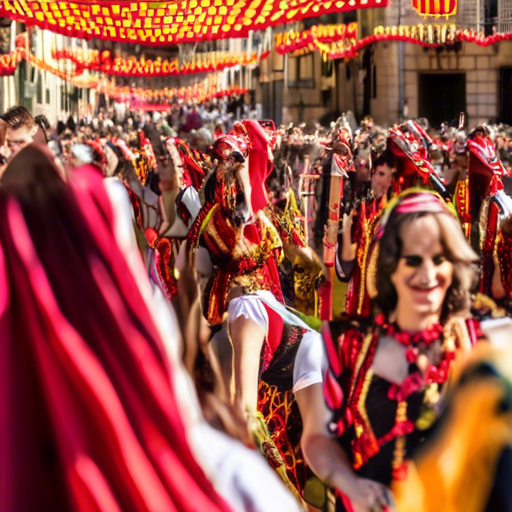top cultural festivals in spain you shouldn't miss

Top Cultural Festivals in Spain You Shouldn't Miss
Spain is renowned for its vibrant culture, rich history, and lively festivals. These events are not just celebrations but a deep dive into the Spanish way of life. From the fiery passion of flamenco to the colorful parades of Semana Santa, Spain offers a plethora of festivals that captivate both locals and tourists alike. In this article, we will explore some of the most iconic cultural festivals in Spain that you shouldn't miss.
La Tomatina
La Tomatina, held in the town of Buñol, is one of the most famous food fights in the world. Every year, on the last Wednesday of August, thousands of participants gather to throw overripe tomatoes at each other in a fun and chaotic event.
History and Significance
The origins of La Tomatina date back to 1945 when a group of young people started a spontaneous tomato fight during a parade. The event was so enjoyable that it became an annual tradition. Today, La Tomatina attracts visitors from all over the globe, eager to participate in this unique and messy celebration.
What to Expect
- Massive Tomato Fight: Over 150,000 tomatoes are used, creating a sea of red in the streets.
- Pre-Fight Festivities: The event kicks off with a "palo jabón," a greasy pole climb to retrieve a ham.
- Post-Fight Clean-Up: Fire trucks and hoses are used to wash down the streets and participants.
For more information on planning your trip to La Tomatina, visit this travel guide.
Semana Santa
Semana Santa, or Holy Week, is a deeply religious and culturally significant festival celebrated across Spain. It takes place during the week leading up to Easter and features elaborate processions, traditional music, and religious ceremonies.
Key Locations
While Semana Santa is celebrated nationwide, some cities are particularly famous for their processions:
- Seville: Known for its grand and solemn processions, Seville's Semana Santa is a must-see.
- Malaga: Features large floats and a more festive atmosphere.
- Zamora: Offers a more intimate and traditional experience.
Highlights
During Semana Santa, you can expect to see:
- Penitents: Participants dressed in traditional robes and hoods, carrying candles and crosses.
- Floats: Intricately decorated floats depicting scenes from the Passion of Christ.
- Saetas: Spontaneous flamenco-style songs sung from balconies.
For a detailed guide on Semana Santa, check out this resource.
Las Fallas
Las Fallas, held in Valencia every March, is a spectacular festival that combines art, fire, and tradition. The event culminates in the burning of large, intricate sculptures known as "fallas."
Origins and Traditions
Las Fallas has its roots in the medieval tradition of burning wooden objects to celebrate the arrival of spring. Over time, these objects evolved into the elaborate sculptures we see today.
Main Events
Las Fallas features a variety of events, including:
- La Plantà: The installation of the fallas sculptures throughout the city.
- La Mascletà: Daily firework displays that create a symphony of noise and light.
- La Cremà: The burning of the fallas on the final night, symbolizing renewal and rebirth.
For more insights into Las Fallas, visit this page.
San Fermín
San Fermín, held in Pamplona in July, is best known for the Running of the Bulls. This adrenaline-pumping event attracts thrill-seekers from around the world.
Historical Background
The festival dates back to the 12th century and honors Saint Fermin, the patron saint of Pamplona. The Running of the Bulls became a central part of the festival in the 14th century.
Festival Highlights
San Fermín offers a range of activities, including:
- Encierro: The Running of the Bulls, where participants run ahead of a group of bulls through the streets.
- Processions: Religious processions honoring Saint Fermin.
- Fireworks: Nightly firework displays that light up the sky.
For safety tips and more information on San Fermín, visit this guide.
Conclusion
Spain's cultural festivals offer a unique glimpse into the country's rich traditions and vibrant spirit. Whether you're drawn to the chaos of La Tomatina, the solemnity of Semana Santa, the artistry of Las Fallas, or the thrill of San Fermín, there's a festival for everyone. These events are not just celebrations; they are an integral part of Spain's cultural heritage, bringing communities together and attracting visitors from around the world.
FAQ
What is the best time to visit Spain for festivals?
The best time to visit Spain for festivals depends on which events you want to experience. La Tomatina takes place in August, Semana Santa in April, Las Fallas in March, and San Fermín in July.
Are these festivals family-friendly?
While some festivals like Semana Santa and Las Fallas are family-friendly, others like La Tomatina and San Fermín may not be suitable for young children due to their chaotic and potentially dangerous nature.
Do I need to buy tickets for these festivals?
Most of these festivals are free to attend. However, some events within the festivals, such as certain seating areas for processions or special activities, may require tickets.
What should I wear to these festivals?
Comfortable clothing and footwear are essential. For La Tomatina, wear old clothes that you don't mind getting ruined. For Semana Santa, modest attire is recommended due to the religious nature of the event.
How can I stay safe during these festivals?
Always follow local guidelines and safety instructions. For events like the Running of the Bulls, ensure you are physically fit and aware of the risks involved. Staying hydrated and keeping personal belongings secure are also crucial.
